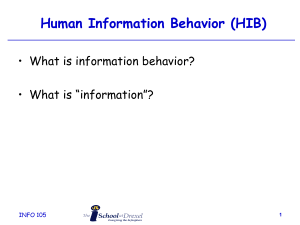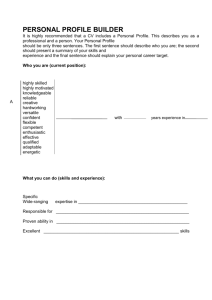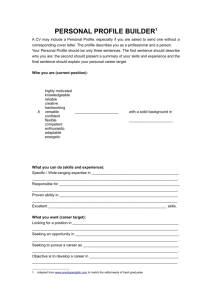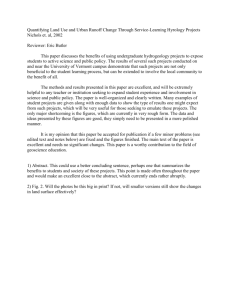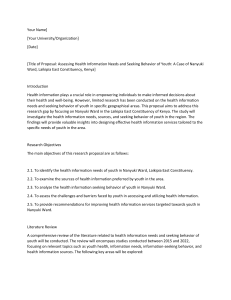Course Portfolio INFO3030 User Studies
advertisement
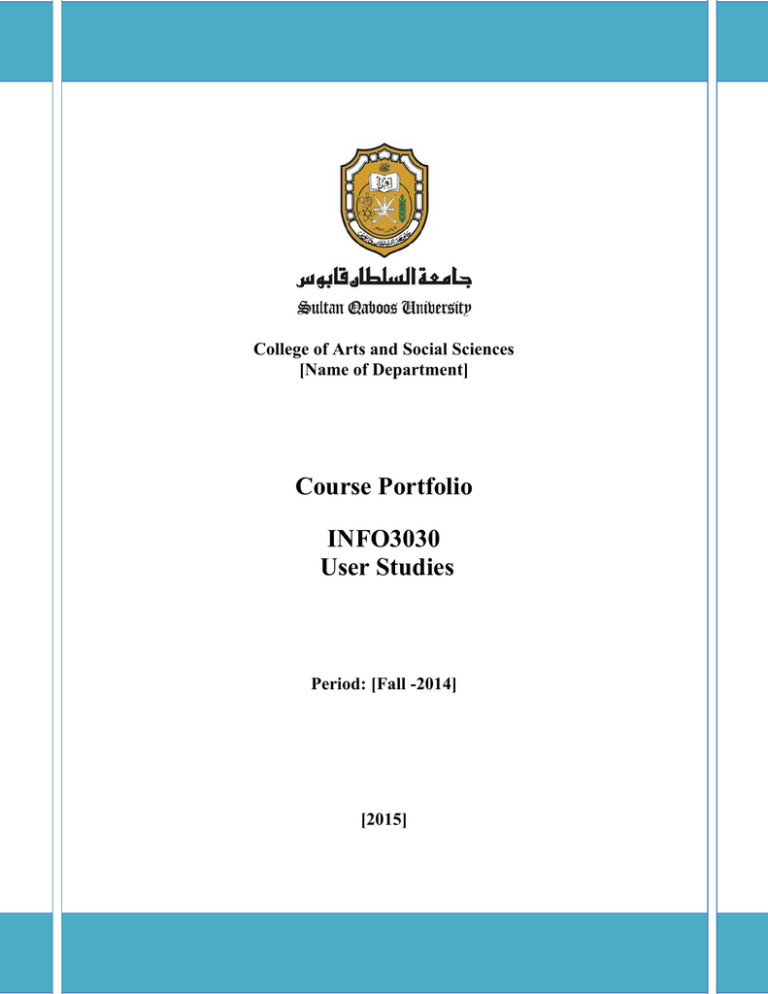
College of Arts and Social Sciences [Name of Department] Course Portfolio INFO3030 User Studies Period: [Fall -2014] [2015] Course File I. COURSE FILE SUMMARY 1. COURSE INFORMATION College/Institute/Centre COLLEGE OF ARTS AND SOCIAL SCIENCES Department Department of Information Studies Program Title Information Studies Semester\Year Fall 2014 Program Code English Course Title User Studies INFO3030 Course Code Arabic دراسات المستفيدين Course Type Pre Requisites None Teaching Language Arabic Credit Hours Teaching Hours Teaching Weeks 3 Lecture ---3-- (Weekly) Practical/Fieldwork ----- (Weekly) --14--- Total --3--- Number of students Lecture Practical/Fieldwork Number of Student dropped 23 0 1 2. COURSE DESCRIPTION ENGLISH COURSE DESCRIPTION ARABIC COURSE DESCRIPTION This course examines the individual and social aspects related to human information needs, information-seeking behavior, and uses. It puts emphasis on the main related elements of the human seeking behavior such as the nature of information, types and characteristics of seekers, models, paradigms, and theories of information behavior, methods for studying information behavior. The course will also touch on the searching strategies and techniques, informal sources of formal and information and electronic resources utilized by users, and barriers affecting users’ information-seeking behavior. 3. COURSE AIM The main objective of the course is to provide students with a comprehensive understanding of user studies and related areas. 4. COURSE OBJECTIVES Examines the individual and social aspects related to human information needs, information-seeking behavior, and uses. Puts emphasis on the major related elements of the human-seeking behavior such as the nature of information, types and characteristics of seekers, models, paradigms, and theories of information behavior, methods for studying information behavior. Touches on the searching strategies and techniques, formal and informal sources of information and electronic resources utilized by users, and barriers affecting users’ information-seeking behavior. 2 5. COURSE INTENDED LEARNING OUTCOMES By the end of this course, students should be able to: • • • • • • Identify the major concepts related to information needs, uses, and informationseeking behavior. Identify models, paradigms, and theories used in user studies. Provide examples of different methods for studying information seeking behavior and strategies and techniques used by various groups of users. Provide more detailed information on information-seeking practices in developing societies in the non-English speaking world, and Identify the perceived and actual barriers to users’ effective information-seeking behavior. Design a framework for practical studies investigating information-seeking behavior in physical or electronic environments. 6. LECTURES SCHEDULE WEEK TOPIC Course Overview and Introduction: content, schedule, assignments, and 1 grading. 2 The Nature and Value of Information The Concept of Information 3&4 Social Role of Libraries and Information Institutions Concepts Related to Information Behavior Information Needs 5 6, 7 & 8 Role of Information in Society Information Seeking Information Use Overview of Research Literature in Information Behavior Theories and Models of Information Behavior Wilson Model Information Grounds Theory Kuhlthau Model Ellis Model Krikelas’ Model of Information Seeking Al-Suqri Model Mid-term Examination 9 10 & 11 Methods for Studying Information Needs, Seeking, and Use Context of Seeking and Characteristics of Seekers 3 12 13 14 15 Online Information Seeking Behavior Information Seeking Behavior in Everyday Life Information Seeking Processes and Barriers Future Trend in Human Information Behavior Studies Revising and Clearing out 7. TEACHING STRATEGIES AND TECHNOLOGY APPLICATION Teaching Method Lectures, Experiential exercises, and Teaching Media Videos Power-point Presentations 8. GRADING AND ASSESSMENT Participation 15% Assignment I: Grant Proposal: Applying for a Research Fund 10% Assignment II: Information Seeking Event or Experience 10% Assignment III: Literature Review Project 15% Assignment IV: Diary of Actions and Thoughts 10% Midterm Exam 10% Final Exam 30% 9. COURSE RULES Attendance Attendance at class is mandatory. Course Instructors should keep attendance records. An "absentee warning notice" will be issued if a student is absent for: • More than 10% in courses with less than 75 total contact hours. • More than 5% in courses with 75 or more total contact hours. An "absentee withdrawal notice" will be issued and the student will be deemed to have withdrawn from the course with an 'FW' grade if a student is absent for: • More than 20% in courses with less than 75 total contact hours. • More than 15% in courses with 75 to 150 total contact hours. • More than 10% of total contact hours for courses with more than 150 total contact hours. 10. INSTRUCTIONAL MATERIALS Books 1. Case, D. (2002). Looking for information: A survey of research on information seeking, needs, and behavior. New York: Academic Press. 4 2. Al-Suqri, M. N., Lillard, L. L., & Al-Saleem, N. E. (2013). Information Access and Library Users Needs in Developing Countries. New York: IGI Global. Articles 1. Abouserie, H. E. M. R. (2003). Information-seeking and communicating behavior of social science faculty in an academic environment with special reference to the use of electronic journals: A field study. Unpublished doctoral dissertation, University of Pittsburgh, Pittsburgh. 2. Akomolafe-Fatuyi, E. & Al-Suqri, M. N. (2012). International Graduate Students in Academic Libraries: A User Survey Usage of Online Catalog at Emporia State University. International Research: Journal of Library & Information Science, 2(2), 143-158. 3. Al-Suqri, M. N. (2014). Perceived Usefulness, Perceived Ease-of-Use and Faculty Acceptance of Electronic Books: An Empirical Investigation of Sultan Qaboos University, Oman. Library Review, 63(4/5), 276-294. doi.org/10.1108/LR-05-2013-0062 4. Al-Suqri, M. N. (2013). The Changing Nature of Information Behavior and the Information Environment: Challenges for LIS in the Arab Gulf States. In M. N. Al-Suqri, L. L. Lillard, & N. E. Al-Saleem (Eds), Information Access and Library Users Needs in Developing Countries (pp. 1-14). New York, IGI Global. 5. Al-Suqri, M. N. (2013). Contextual Factors Influencing Information Seeking Behavior of Social Scientists: A Review of the Literature. In M. N. Al-Suqri, L. L. Lillard, & N. E. Al-Saleem (Eds), Information Access and Library Users Needs in Developing Countries (pp. 190-210). New York, IGI Global. 6. Al-Suqri, M. N., & Lillard, L. (2011). Barriers to Effective Information Seeking of Social Scientists in Developing Countries: The Case of Sultan Qaboos University in Oman. International Research: Journal of Library & Information Science, 1(2), 86-100. 7. Al-Suqri, M. N. (2011). Information Seeking Behavior of Social Science Scholars in Developing Countries: A Proposed Model. The International Information and Library Review, 43, 1-14. DOI: 10.1016/j.iilr.2011.01.001 8. Al-Suqri, M. N. (2010). Socio-Demographic Differences in Information Seeking Behavior of Social Science Scholars in Developing Countries: The Case of Sultan Qaboos University. Information Studies, 9, 51-68. 9. Bass, A., Fairlee, J., Fox, K., & Sullivan, J. (2005). The information behavior of scholars in the humanities and social sciences. Retrieved December 2, 2005, 5 from http://ischool.washington.edu/harryb/courses/LIS510/Assign_2/Team_2_ Scholar.pdf 10. Bouazza, A. (1986). Use of information sources by physical scientists, social scientists, humanities scholars at Carnegie-Mellon University. Unpublished doctoral dissertation, University of Pittsburgh, Pittsburgh. 11. Brittain, J. M. (1970). Information and its users: A review with special reference to the social science. New York: Wiley Inter-science. 12. Brittain, J. M. (1984). Internationality of the Social Sciences: Implications for information transfer. Journal of the American Society for Information Science, 35(1), 11-18. 13. Brittain, J. M. (1986). Cultural boundaries of the social science in the 1990s; new polices for documentation, information and knowledge creation. International Social Science Journal, 41, 105-114. 14. Broadbent, E. (1986). A study of humanities faculty library informationseeking behaviour. Cataloging & Classification Quarterly, 6, 23-37. 15. Broadus, R. N. (1971). The literature of the social sciences: A survey of citation studies. International Social Sciences Journal, 23, 236-243. 16. Brown, C. M. (1999). Information seeking behavior of scientists in the electronic information age: Astronomers, chemists, mathematicians, and physicists. Journal of the American Society for Information Science, 50(10), 929-943. 17. Bu-Merafi, B. M. (2001). Use of Internet by the teaching staff at the university of Al-Sharqa. Risalat Al-Maktaba, 36(1/2), 74-90. 18. Busha, C. H., & Harter, S. P. (1980). Research Methods in Librarianship: Techniques and interpretations. New York: Academic Press. 19. Buttlar, L. & Wynar, L. R. (1992). Cultural pluralism and ethnic diversity: Authors as information users in the field of ethnic studies. Collection Management, 16(3), 13-33. 6 20. Case, D. O. (2002). Looking for information: A survey of research on information seeking, needs, and behavior. New York: Academic Press. 21. Choo, C. W., Detlor, B., & Turnbull, D. (2000a). Information-seeking on the Web: An integrated model of browsing and searching. First Monday, 5(2). Retrieved June 7, 2006, from http://firstmonday.org/issues/issue5_2/choo/index.html. 22. Choo, C. W., Detlor, B., & Turnbull, D. (2000b). Working the Web: An empirical model of Web use. Retrieved June 7, 2006, from http://www.ischool.utexas.edu/~donturn/papers/hicss2000/hicss2000.html. 23. Kuhlthau, C. C. (1991). Inside the search process: Information seeking from the user’s perspective. Journal of the American Society for Information Science 42(5), 361-371. 24. Kuhlthau, C. C. (1993). Seeking meaning: A process approach to library and information services. Norwood, NJ: Ablex Publishing Corporation. 25. Kuhlthau, C. C. (2004). Seeking meaning: A process approach to library and information services. Westport, CT: Libraries Limited. 26. Kuhlthau, C. C. (2005). Kuhlthau's information search process. In K. E. Fisher; S. Erdelez; & L. E. F. Mckechnie (Eds.). Theories of information behavior (pp. 30- 234). Medford, NJ: Information Today, Inc. 27. Meho, L. I. (2001). The information-seeking behavior of social science faculty studying stateless nations. Unpublished doctoral dissertation, University of North Carolina, Chapel Hill. 28. Meho, L. I., & Haas, S. W. (2001). Information-seeking behavior and use of social science faculty studying stateless nations: A case study. Library & Information Science Research, 23(1), 5-25. 29. Meho, L., & Tibbo, H. (2003). Modeling the information-seeking behavior of social scientists: Ellis’s study revisited. Journal of the American Society for Information Science and Technology, 54(6), 570-587. 30. Talja, S., & Maula, H. (2003). Reasons for the use and nonuse of electronic journals and databases: A domain analytic study in four scholarly disciplines. Journal of Documentation, 59(5), 673-691. 7 31. Tenopir, C. (2003). Use and users of electronic library resources: An overview and analysis of recent research studies. Washington, D.C.: Council on Library and Information Resources. Retrieved May 12, 2005, from http://www.clir.org/pubs/abstract/pub120abst.html. 32. Tenopir, C. & King, D. (2001). Electronic journals: How user behaviour is changing in online information. Oxford, London: Learned Information Europe Ltd. 33. Tomney, H. & Burton, P. F. (1998). Electronic journals: A study of usage and attitudes among academics. Journal of Information Science, 24(6), 419-429. 34. Talja, S., & Maula, H. (2003). Reasons for the use and nonuse of electronic journals and databases: A domain analytic study in four scholarly disciplines. Journal of Documentation, 59(5), 673-691. 35. Tenopir, C. (2003). Use and users of electronic library resources: An overview and analysis of recent research studies. Washington, D.C.: Council on Library and Information Resources. Retrieved May 12, 2005, from http://www.clir.org/pubs/abstract/pub120abst.html. 36. Tenopir, C. & King, D. (2001). Electronic journals: How user behaviour is changing in online information. Oxford, London: Learned Information Europe Ltd. 37. Tomney, H. & Burton, P. F. (1998). Electronic journals: A study of usage and attitudes among academics. Journal of Information Science, 24(6), 419-429. 38. Wilson, T. D. (1999). Models of information behaviour research. Journal of Documentation, 55(3), 249-270. 39. Wilson, T.D. (2000). Human information behavior. Informing Sciences, 3(2), 49-55. 40. Wilson, T. D., & Streatfield, D. R. (1981). Action research and users' needs. Retrieved November 2, 2005, from http://informationr.net/tdw/publ/papers/action81.html. 41. Yitzhake, M. & Hammershlag, G. (2004). Accessibility and use of information sources among computer scientists and software engineers in Israel: Academy versus industry. Journal of the American Society for Information Science, 55(9), 832-842. 42. Younis, A. R. M. (2002). The perception and administrative effect of Internet usage in Jordanian university libraries. Online Information Review, 26(3), 193208. 8 II. III. IV. V. VI. VII. VIII. LECTURES LECTURE NOTES/HAND-OUTS EXAMS SAMPLE A SAMPLE OF STUDENTS’ ANSWERS A SAMPLE OF EXERCISES AND STUDENTS’ ANSWERS A SAMPLE OF ASSIGNMENTS AND STUDENTS’ ACTIVITIES RESULTS AND GRADES 9
